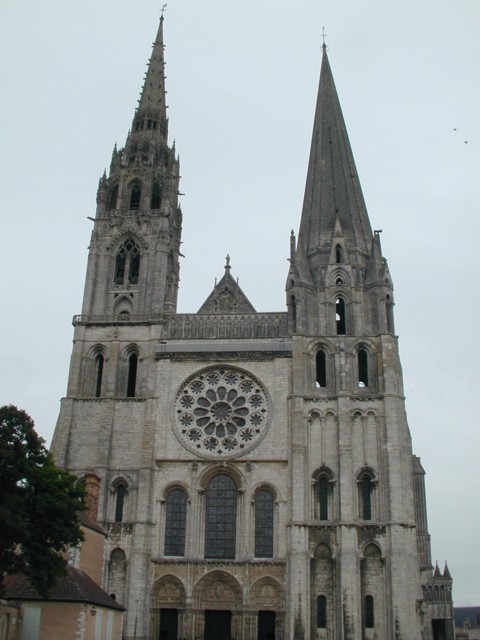

Today we packed up for the last time until we come home, and got onto the buses to drive to Paris! On the way we stopped at one of those places that I had read about for years in history books but had never expected to visit, let alone sing in: the cathedral of Our Lady of Chartres. This is the best-preserved Gothic cathedral in the world, having passed through wars and revolutions, anticlerical mobs and "friendly fire," almost unscathed for eight hundred years. The windows were disassembled piece by piece and hidden in caves along the river Dordogne for safety during the two world wars; however, they almost didn't have a cathedral to come back to after the second, since the Germans had an airstrip nearby and when the Allies attacked it to prepare for the liberation of Europe some stray bombs came awfully close to the cathedral.
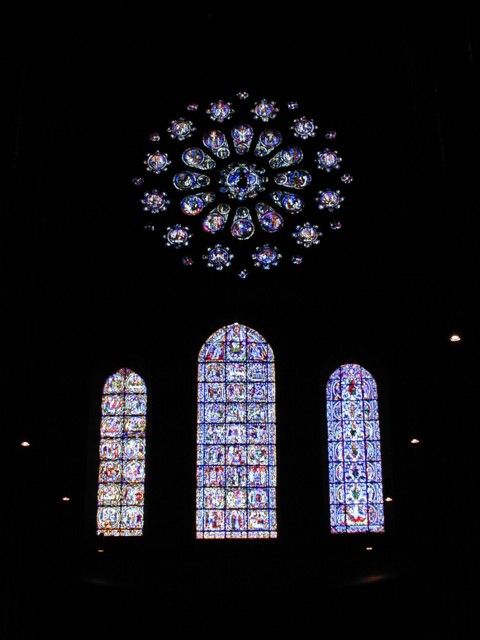
The pride of Chartres, architecturally speaking, is its collection of over 150 12th- to 13th-century stained-glass windows. The cathedral also boasts nine sculpted doors and over 4000 statues; all together, it is "a book in glass and stone," intended to instruct visitors in the stories of the Bible from Genesis to Revelations, the beginning of the world to the end. These are the windows at the west end of the cathedral, seen from outside above the main entrance in the previous photo; the three below the rose window are the oldest in the cathedral. It's hard to get an idea of the scale of these windows just from a photo, or even by looking at them up high (high!) on the wall, but the individual panels are about four feet square. The panels are intended to be "read" from left to right and bottom to top; the rightmost window tells the genealogy of Christ, the middle one shows scenes from His Incarnation, and the leftmost window depicts the events of Holy Week.
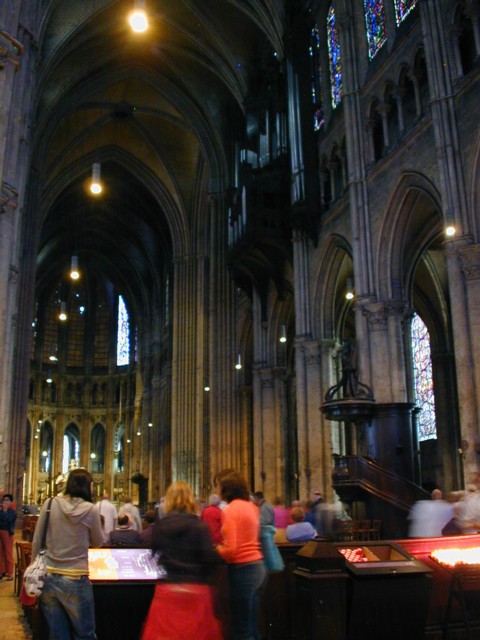
This is by far the largest church we've visited on this trip; here we are looking east through the nave toward the altar, with the pipes of the organ high up on the south wall. The reason that the cathedral had to be built so large is that it was a great pilgrimage site by about the eleventh century; its main holy relic is what is claimed to be the clothes Mary wore at Jesus' birth. (Tests show that it dates to the first century, so maybe...) Chartres is an old city, going back to Roman times, and there has been a bishop here since Christianity was legalized by Constantine's Edict of Milan in 313; there have been five cathedrals (churches with a bishop's throne, or cathedra) on this site since then, and the relic was given to the church in 875 by the grandson of Charlemagne, probably in honor of the consecration of the third cathedral in 876.
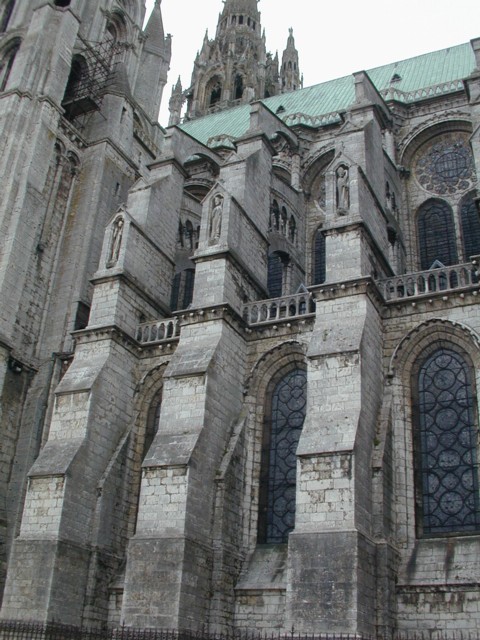
Here you can see the innovation that enabled Gothic cathedrals to rise to so much greater heights than Romanesque: the flying buttress. The columns inside are braced externally by the heavy buttresses of which you can see three here, going down to the ground; the upper stories are reinforced by the more delicate-looking open arches. Without this external reinforcement, such a tall structure would collapse outward under the weight of the roof and the upper floors.
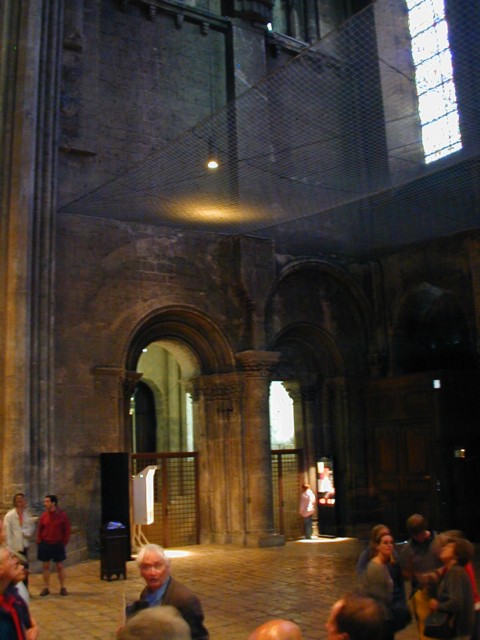
The relics of the cathedral are kept in an underground crypt. In 1020 the third cathedral was destroyed by fire (how does a stone church burn down? the roof is made of wood, and if it goes the walls can collapse); Bishop Fulbert built the largest crypt in France surrounding the old one, and atop it a large Romanesque church occupying much of the space of the present cathedral. The cathedral was lengthened in the 12th century, with the present towers being added at that time; the steeple was built on the south tower in the 1160s, but the north steeple (taller one on left in the photo at top of this webpage) was built four centuries later in the late "flamboyant Gothic" style. In 1194 the fourth cathedral was destroyed by fire; the only aboveground structures to survive were the towers and main entrance, so what you see here (inside the entrance, looking at the south tower--the netting is to catch plaster falling from the ceiling) is the oldest part of the present cathedral. The crypts also survived, and three days later (where have we heard that figure before?) the priests brought the relics up from them. This was publicized as a miracle, showing that Mary intended the cathedral to be rebuilt, and in a burst of enthusiasm and effort the job was largely completed by 1220.
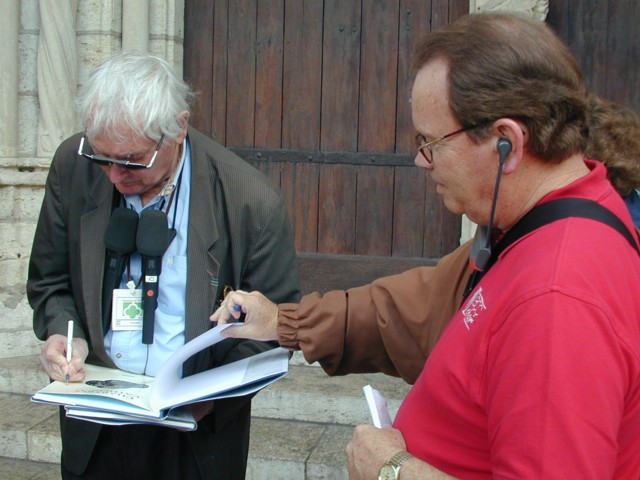
This is our guide: Malcolm Miller, a historian who has been studying the cathedral of Chartres for almost half a century now. He's the author of several books on the cathedral, one of which he autographs here for Jim Belt; looking at the credits for that book, I see that France has named him a Chevalier de l'Ordre National du Mérite, and a Chevalier de l'Ordre des Arts et des Letters, for his contributions to the scholarship of this important piece of the nation's heritage. It was a privilege to have someone this distinguished guide us on our (regrettably brief) tour of the cathedral; and he's a great storyteller, too! (Note the headphones Jim's wearing, and the mikes worn by our guide; that's so he can speak quietly and still be heard by a large group like ours, so as not to have to disturb other visitors to the cathedral by shouting.)
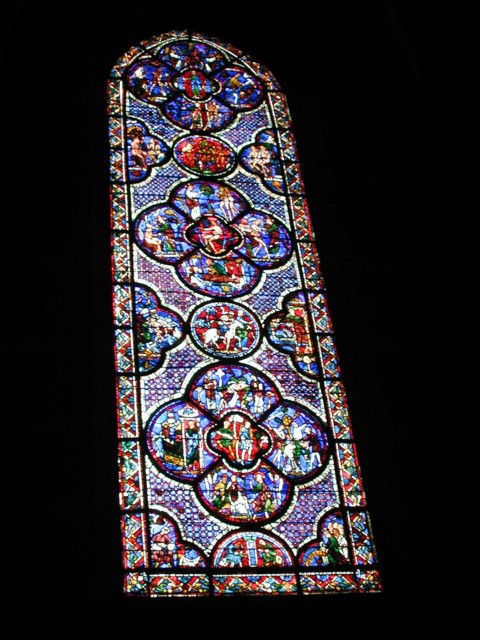
He pointed out just a few of the myriad details that the builders of the cathedral "wrote" in stone and glass to tell future pilgrims the story of Christ prophesied and prefigured in the Old Testament and made flesh in the New. This is one of dozens of windows donated by the guilds during construction of the cathedral, in this case by the shoemakers in 1210. (Sorry about the bad perspective, but I had to brace my camera against an awkwardly-placed pillar to steady it during the long exposure with no flash.) This window shows the parable of the Good Samaritan, and also the story of Adam and Eve; the juxtaposition is intended to teach an interpretation of the parable that goes back at least to St. Irenaeus in the second century. Jesus' parable tells of a man who is attacked and left for dead by robbers; two of his countrymen and co-religionists, a priest and a scribe, see him but pass on by, but then a stranger from Samaria picks him up, carries him to an inn, and arranges with the innkeeper to return later to settle accounts for whatever expenses he incurs caring for the man. In Irenaeus' interpretation, Christ is the Samaritan, who picks up fallen man (whence the link with Adam and Eve), brings him to the church (the inn) to be cared for, and says that he will return to settle accounts (Judgment Day). So we have not just a retelling of familiar stories here but a theology lesson, told without writing.
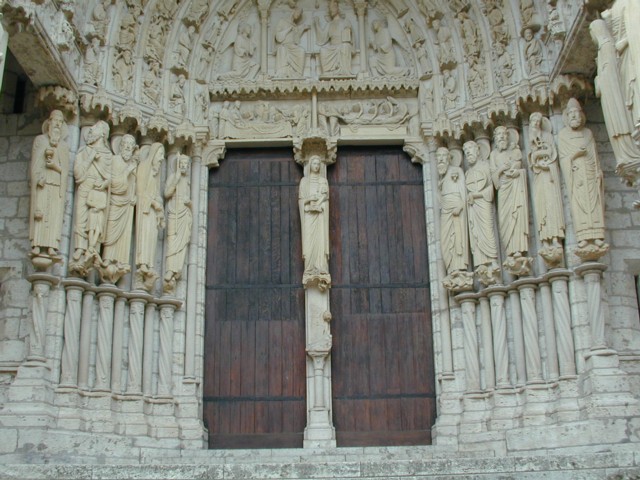
The sculptures surrounding the north entrance also give a lesson, in this case on the progression from prophecy to its fulfillment as the Old gives way to the New Testament. For example, the second figure from left on the left side of the door is Abraham, whose interrupted sacrifice of his son Isaac prefigures the sacrifice of Christ, the Son of God; second from left on the right side is Jeremiah, who foretold the coming of the Messiah. The set of figures is intended to convey the progression from Melchizedek at the extreme left, who holds the bread and wine with which he welcomed Abraham, to Peter at the extreme right, who holds (now broken from the statue) the bread and wine of Christian communion. This entrance was recently cleaned; the yellowish color of the figures is "sizing" or primer, since originally these statues would have been painted. If you look closely (in real life, probably not in my photo) you can see some traces of pigment, like green on a dragon being trodden by one of these figures.
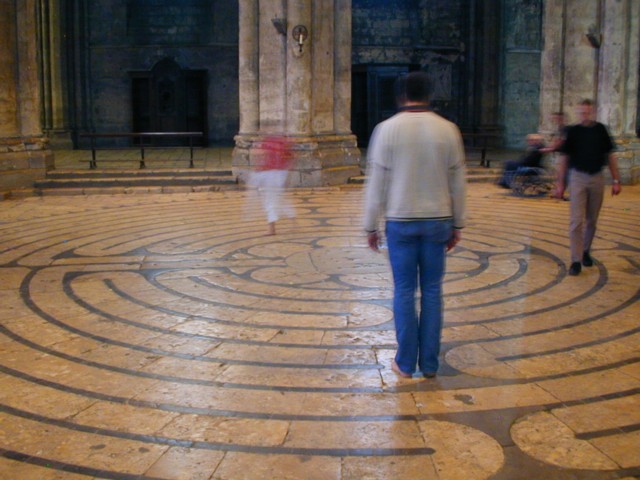
In the middle of the nave, laid out in tiles on the floor, is a spiral pattern, a labyrinth. On Fridays they clear the chairs out of this section, and the devout come to walk the paths of the labyrinth, often barefoot; this is a ritual of meditation and prayer that I had heard of but never seen. It was a bit too bad that people kept barging across the labyrinth on their way from one end of the cathedral to the other, but I guess part of meditation is to shut out external distractions.
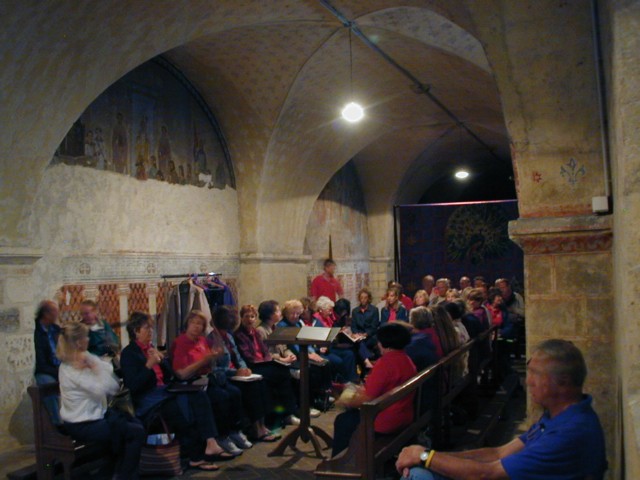
In order not to disturb other visitors, we were allowed to go down into the crypt to rehearse for half an hour or so, while Lee went up to (quietly!) check out the organ. Unfortunately, this meant that we were not able to rehearse with her upstairs on the organ, and in fact we had difficulty hearing each other; there was reverberation in the cathedral, but from such a distance that it didn't help us much, though it gave a nice ring to our closing chords. Pat anticipated this, and just in case we had trouble we rehearsed a couple of our accompanied songs without piano or organ, to see if we liked the way they sounded a capella. I think they worked pretty well a capella, actually ("Order My Steps" and "Lord, Listen to Your Children").
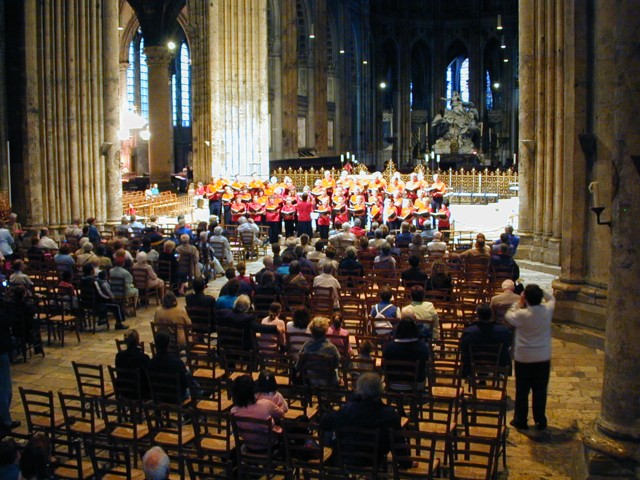
Ambassador Tours had printed up some flyers advertising all our concerts, and I think the cathedral did too, so we had an audience that probably included people who came specifically to hear us as well as visitors who just happened to be within earshot. The audience appeared to enjoy the music, which we selected from our sacred repertoire (no jazz or "Phantom" medley!), and applauded us as we walked off the steps. Thanks yet again to Steve Campbell for a steady hand on the camera. By the way, we haven't switched to orange shirts! There appears to be something screwy with the color balance during the long exposures necessary to get photos in such low light. And the light was low; it was quite gray and intermittently rainy outside, which reduced the light filtering in through the heavily-colored (and in some cases dirty) windows, and these photographs give a false impression of more light than we really had inside the cathedral.
Well, this is our last concert on this tour; we sing one more time, at Mass in Notre Dame de Paris on Sunday, but we're not the center of attention there and will only sing about four songs. We called this an "informal" concert because we wore our polo shirts, not our black suits and dresses, and because we didn't have an intermission; however, we'd been warned that the lady in charge of guest choirs in the cathedral was quite severe about repertoire and punctuality, so we definitely tried to be on our good behavior! It is certainly an honor to sing in a place with hundreds of years of devotion soaked into the stones. Singing about "the great I AM" at the climax of "Mary, Did You Know?" while looking up at the ancient western windows, I choked up pretty thoroughly; fortunately, the women sing the next couple of pages without us, so I was able to pull myself together! It's moments like this that make you realize why you put yourself through the eleven-hour flights and separation from your loved ones so that you can sing in places you've known about for years but only seen in books.
 To
Saturday, 9 July 2005
To
Saturday, 9 July 2005 Back
to choir tour itinerary
Back
to choir tour itinerary Back
to choir tour home page
Back
to choir tour home pagenew 8 July 2005